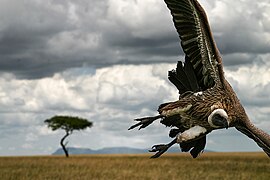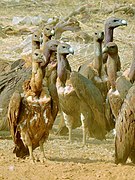Vulture
| Vulture Temporal range: [1]
| |
|---|---|

| |
| Scientific classification | |
| Domain: | Eukaryota |
| Kingdom: | Animalia |
| Phylum: | Chordata |
| Clade: | Ornithurae |
| Class: | Aves |
| Families | |
| |
A vulture is a bird of prey that scavenges on carrion. There are 23 extant species of vulture (including condors).[2] Old World vultures include 16 living species native to Europe, Africa, and Asia; New World vultures are restricted to North and South America and consist of seven identified species, all belonging to the Cathartidae family.[2][3] A particular characteristic of many vultures is a bald, unfeathered
Vultures have been observed to hunch their bodies and tuck in their heads in the cold, and open their wings and stretch their necks in the heat. They also urinate on themselves as a means of cooling their bodies.[5]
A group of vultures in flight is called a 'kettle', while the term 'committee' refers to a group of vultures resting on the ground or in trees. A group of vultures that are feeding is termed a 'wake'.[6]
Taxonomy
Although New World vultures and Old World vultures share many resemblances, they are not very closely related. Rather, they share resemblance because of convergent evolution.[7]
Early naturalists placed all vultures under one single biological group. Carl Linnaeus had assigned both Old World vultures and New World vultures in a Vultur genus, even including the harpy eagle. Soon anatomists split Old and New World vultures, with New World vultures being placed in a new suborder, Cathartae, later renamed Cathartidae as per the Rules of Nomenclature (from Greek: carthartes, meaning "purifier")[8] by French ornithologist Frédéric de Lafresnaye.[9] The suborder was later recognised as a family, rather than a suborder.
In the late 20th century, some ornithologists argued that New World vultures are more closely related to
Old World
The Old World vultures found in Africa, Asia, and Europe belong to the family Accipitridae, which also includes eagles, kites, buzzards, and hawks. Old World vultures find carcasses exclusively by sight.
The 16 species in 9 genera are:
- Cinereous vulture, Aegypius monachus
- Griffon vulture, Gyps fulvus
- White-rumped vulture, Gyps bengalensis
- Rüppell's vulture, Gyps rueppelli
- Indian vulture, Gyps indicus
- Slender-billed vulture, Gyps tenuirostris
- Himalayan vulture, Gyps himalayensis
- White-backed vulture, Gyps africanus
- Cape vulture, Gyps coprotheres
- Hooded vulture, Necrosyrtes monachus
- Red-headed vulture, Sarcogyps calvus
- Lappet-faced vulture, Torgos tracheliotos
- White-headed vulture, Trigonoceps occipitalis
- Bearded vulture (Lammergeier), Gypaetus barbatus
- Egyptian vulture, Neophron percnopterus
- Palm-nut vulture, Gypohierax angolensis
-
Some members of both the Old and New World vultures have an unfeathered neck and head, shown as radiating heat in this thermographic image.
-
Griffon vultures scavenging a red deer carcass in Spain
-
Griffon vulture soaring
-
Vulture preparing to land in Kenya
-
African hooded vulture in Kruger National Park
-
Flock of white-rumped vultures in India
-
Head of a vulture chick, Iran
New World

The
- Black vulture Coragyps atratus in South America and north to the US
- Turkey vulture Cathartes aura throughout the Americas to southern Canada
- Lesser yellow-headed vulture Cathartes burrovianus in South America and north to Mexico
- Amazon Basinof tropical South America
- California condor Gymnogyps californianus in California, formerly widespread in the mountains of western North America
- Andean condor Vultur gryphus in the Andes
- King vulture Sarcoramphus papa from southern Mexico to northern Argentina
Feeding
Vultures are scavengers, meaning that they eat dead animals. Outside of the oceans, vultures are the only known obligate scavengers.[20] They rarely attack healthy animals, but may kill the wounded or sick. When a carcass has too thick a hide for its beak to open, it waits for a larger scavenger to eat first.[21] Vast numbers have been seen upon battlefields. They gorge themselves when prey is abundant, until their crops bulge, and sit, sleepy or half torpid, to digest their food. These birds do not carry food to their young in their talons but disgorge it from their crops. The mountain-dwelling bearded vulture is the only vertebrate to specialize in eating bones; it carries bones to the nest for the young, and hunts some live prey.[22]
Vultures are of great value as scavengers, especially in hot regions. Vulture
In various regions of Africa, the dynamic interplay of vultures and predators such as lions, cheetahs, hyenas, and jackals significantly influences the continent's food web. These avian scavengers actively engage in competition with these predatory animals for sustenance, meticulously tracking their hunting activities.[25]
Traditionally, vultures are known to bide their time, patiently observing from a distance or high in the sky as predators bring down their prey and commence feeding. Once these formidable predators have satiated their hunger and moved away from their kills, the vultures swoop in, making the most of the leftovers.
New research has revealed that these birds can, in addition to sight, respond to auditory cues indicative of potential foraging opportunities.[26]
Interaction between vultures and predators is not strictly sequential or one-sided. Vultures, being opportunistic creatures, will often engage in risky behavior if a prime opportunity arises. Sometimes, when the predator numbers are low or distracted, these large birds might move in earlier, attempting to snatch morsels from the kill before the predators have fully vacated the scene. This daring strategy, while high-risk, underscores the fierce competition and survival instincts prevalent in the harsh realities of the African wild.[27]
New World vultures also urinate straight down their legs; the uric acid kills bacteria accumulated from walking through carcasses, and also acts as evaporative cooling.[28]
Conservation status
Vultures in south Asia, mainly in India and
The vulture population is threatened across Africa and Eurasia. There are many human activities that threaten vultures such as poisoning and collisions with wind turbines.[33] In central Africa there have been efforts to conserve the remaining vultures and bring their population numbers back up. The decline is largely due to the trade in vulture meat, "it is estimated that more than 1×109 kg [2.2×109 lb] of wild animal meat is traded" and vultures take up a large percentage of this bushmeat due to the demand in the fetish market.[34] The substantial drop in vulture populations in the continent of Africa is also said to be the result of both intentional and unintentional poisoning, with one study finding it to be the cause of 61% of the vulture deaths recorded.[35]
A recent study in 2016, reported that "of the 22 vulture species, nine are critically endangered, three are endangered, four are near threatened, and six are least concern".[36]
The conservation status of vultures is of particular concern to humans. For example, the decline of vulture populations can lead to increased disease transmission and resource damage, through increased populations of disease
On 20 June 2019, the corpses of 468 white-backed vultures, 17 white-headed vultures, 28 hooded vultures, 14 lappet-faced vultures and 10 cape vultures, altogether 537 vultures, besides 2 tawny eagles, were found in northern Botswana. It is suspected that they died after eating the corpses of three elephants that were poisoned by poachers, possibly to avoid detection by the birds, which help rangers to track poaching activity by circling above dead animals.[38][39][40]
In myth and culture
In
Ancient Egyptians believed that all vultures were female and were spontaneously born from eggs without the intervention of a male, and therefore linked the birds to purity and motherhood, but also the eternal cycle of death and rebirth for their ability to transform the "death" they feed on – i.e. carrion and waste – into life.[43]
In Pre-Columbian times, vultures were appreciated as extraordinary beings and had high iconographic status. They appear in many Mesoamerican myths, legends, and fables from civilizations such as the Maya and Aztecs, some depicting them negatively, others positively.[44]
-
The Aztec vulture vessel at the new Pre-Columbian Mesoamerican Pottery Gallery
-
Granite vulture from Temple of Taharqa, Sanam Abu Dom, Napatan Period, 25th Dynasty
See also
References
- ^ "Fossilworks:Aegypiinae". Fossilworks. Retrieved 17 December 2021.
- ^ a b "Dropping dead: causes and consequences of vulture population declines worldwide" (PDF). 2001.
- JSTOR 1367720.
- .
- JSTOR 1368848.
- ISBN 978-1-61069-342-4.
- ^ Phillips (2000)
- ^ Brookes (2006)
- ^ Notes on the Taxonomy of Vultures The Condor Vol. 79, No. 4. 1977. pp. 413–416.
- ^ de Boer (1975)
- ^ Ligon (1967)
- ^ König (1982)
- ^ Griffiths (1994)
- ^ Fain & Houde (2004)
- ^ Avise (1994)
- ^ Brown (2009)
- ^ Cracraft et al. (2004)
- ^ Gibb et al. (2007)
- ^ Ericson et al. (2006)
- PMID 15135041.
- ^ "Fast Vulture Facts". WebVulture.com. Archived from the original on July 18, 2011. Retrieved February 15, 2013.
- ^ PMID 27404248.
- ^ Caryl, Jim (September 7, 2000). "Re: How come that vultures can resist dangerous toxins when feeding on carcass". MadSci Network. Retrieved February 15, 2013.
- ^ "Turkey Vulture Facts". Turkey Vulture Society. Retrieved 2012-12-01.
- ^ "Birds That Are Scavengers and Their Importance To The Ecosystem | STP News". 2023-06-06. Retrieved 2023-06-07.
- ^ "Vultures respond to auditory cues - AfricanBioServices". 2020-05-20. Retrieved 2023-06-07.
- ^ "Food fight: Jackal takes on vultures over a carcass | Predator vs Prey | Earth Touch News". Earth Touch News Network. 2015. Retrieved 2023-06-07.
- ^ Conger, Cristen (2008-10-13). "Why is it a bad idea to scare a vulture?". HowStuffWorks. Retrieved February 15, 2013.
- doi:10.1016/S0006-3207(02)00164-7. Archived from the original (PDF) on 2014-08-12. Retrieved 2014-08-10.)
{{cite journal}}: CS1 maint: numeric names: authors list (link - S2CID 16146840.
- PMID 23145090.
- ^ van Dooren, T. (2011). "Vultures and their People in India: Equity and Entanglement in a Time of Extinctions". Australian Humanities Review (50). Archived from the original on 2016-10-11. Retrieved 2016-09-24.
- PMID 30645009.
- .
- hdl:10023/8817.
- .
- S2CID 167209009.
- Agence France-Press. NDTV. 2019-06-21. Retrieved 2019-06-28.
- ^ Hurworth, Ella (2019). "More than 500 endangered vultures die after eating poisoned elephant carcasses". CNN. Retrieved 2019-06-28.
- ^ Solly, M. (2019). "Poachers' Poison Kills 530 Endangered Vultures in Botswana". Smithsonian. Retrieved 2019-06-28.
- ^ Wilkinson, R.H. (2003). The Complete Gods and Goddesses of Ancient Egypt. Thames & Hudson. pp. 213–214.
- ^ "The Ancient Egyptian Goddess of Pregnancy".
- ^ "Life Egyptian Vulture". 2018.
- ^ Benson, Elizabeth P. The Vulture: The Sky and the Earth.
External links
- Vulture videos on the Internet Bird Collection
- Ventana Wildlife Society Archived 2016-10-19 at the Wayback Machine
- Vulture observatory in Spain
- A Vulture Restaurant
- Declining Vulture Count in India
- Vulture Conservation in Western Coast of India Archived 2017-06-01 at the Wayback Machine
- Website for journal Vulture News











